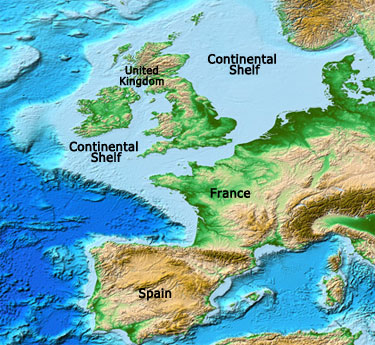Home > Ocean > Oceanography > Geography of the Sea > Continental Shelf
Continental Shelves
Along the shores of most of the major continents around the globe, the sea floor slopes gently downward so gradually that a wide shelf forms just offshore. The width of these relatively shallow shelves varies from just a few miles to several hundred miles from shore. At the outermost edges of these shelves the sea floor slopes abruptly and steeply to the abyssal plain. Scientists believe that the continental shelves mark the true outline of the land forms that are our continents and were exposed as shorelines in the geologic past when sea levels were much lower than today.
 The continental shelves are not considered part of the ocean floor proper, but as the flooded margins of a continent. Under the United Nations Convention on the Law of the Sea, the name continental shelf was given a legal definition as the stretch of the seabed adjacent to the shores of a particular country to which it belongs. With a few exceptions, the shelf break of the continental margins is located at a remarkably uniform depth of about 140 m (460 ft). Scientists believe this depth marks the ancient shorelines of the continents during past ice ages, when sea level was lower than it is now. The continental shelves are not considered part of the ocean floor proper, but as the flooded margins of a continent. Under the United Nations Convention on the Law of the Sea, the name continental shelf was given a legal definition as the stretch of the seabed adjacent to the shores of a particular country to which it belongs. With a few exceptions, the shelf break of the continental margins is located at a remarkably uniform depth of about 140 m (460 ft). Scientists believe this depth marks the ancient shorelines of the continents during past ice ages, when sea level was lower than it is now.
Where is the deepest submarine canyon and how deep is it? ->
|
Get Your Degree!
Find schools and get information on the program that’s right for you.
Powered by Campus Explorer
|

